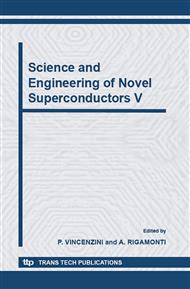[1]
K. Likharev and V. K. Semenov: IEEE Trans. Appl. Supercond. Vol. 1 (1991), p.3.
Google Scholar
[2]
O. Mukhanov, D. Gupta, A. Kadin, and V. Semenov: Proceedings of IEEE Vol. 92, No. 10 (2004), p.1564.
Google Scholar
[3]
S. Nagasawa, Y. Hashimoto, H. Numata, and S. Tahara: IEEE Trans. on Appl. Supercond. Vol. 5 (1995), p.2447.
Google Scholar
[4]
W. Chen, A. Rylyakov, V. Patel, J. Lukens, and K. Likharev: Appl. Phys. Lett. Vol. 73 (1998), p.2817.
Google Scholar
[5]
Y. Hashimoto, S. Yorozu, Y. Kameda, and V. K. Semenov: IEEE Trans. Appl. Supercond. Vol. 13 (2003), p.535.
Google Scholar
[6]
Y. Hashimoto, S. Yorozu, H. Terai and A. Fujimaki: Physica C Vol. 392-396 (2003), p.1472.
Google Scholar
[7]
Y. Hashimoto, S. Yorozu, Y. Kameda, A. Fujimaki, H. Terai, and N. Yoshikawa: IEEE Trans. Appl. Supercond. Vol. 15, (2005), p.356.
DOI: 10.1109/tasc.2005.849862
Google Scholar
[8]
http: /www. cadence. com.
Google Scholar
[9]
Y. Kameda, S. Yorozu, Y. Hashimoto, H. Terai, A. Fujimaki, and N. Yoshikawa: IEEE Trans. Appl. Supercond. Vol. 15, (2005), p.6.
DOI: 10.1109/tasc.2005.849862
Google Scholar
[10]
S. Yorozu, Y. Kameda, H. Terai, A. Fujimaki, T. Yamada, and S. Tahara: Physica C Vol. 378-381 (2002), p.1471.
DOI: 10.1016/s0921-4534(02)01759-8
Google Scholar
[11]
A. Kirichenko, O. A. Mukhanov, and A. Ryzhikh: IEEE Trans. Appl. Supercond. Vol. 7 (1997), p.3438.
Google Scholar
[12]
T. Yamada, A. Sekiya, A. Akahori, A. Fujimaki, H. Hayakawa, Y. Kameda, S. Yorozu, and H. Terai: Supercond. Sci. Technol., No. 14 (2001), p.1071.
DOI: 10.1088/0953-2048/14/12/319
Google Scholar
[13]
http: /www. shicryogenics. com/index. jssx.
Google Scholar
[14]
O. Mukhanov, S. Rylov, D. Gaidarenko, N. Dubash, and V. Borzenets: IEEE Trans. Appl. Supercond. Vol. 7 (1997), p.2826.
DOI: 10.1109/77.621825
Google Scholar
[15]
Y. Hashimoto, S. Yorozu, T. Satoh, and T. Miyazaki: Appl. Phys. Lett. Vol. 87 (2005), 022502.
Google Scholar
[16]
Y. Kameda, S. Yorozu, Y. Hashimoto, H. Terai, A. Fujimaki, and N. Yoshikawa: IEEE Trans. Appl. Supercond. Vol. 15 (2005), p.423.
DOI: 10.1109/tasc.2005.849865
Google Scholar


